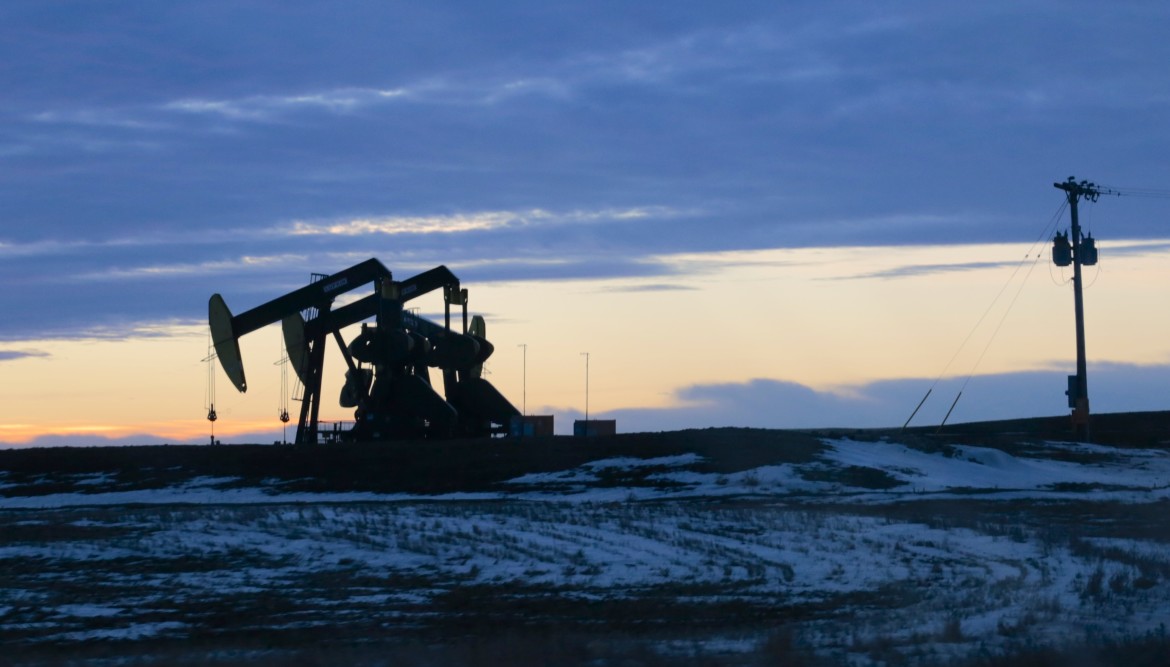
Emily Guerin / Inside Energy
An oil well pad outside Tioga, North Dakota.
Want to take a deep dive into what’s happening in the oilfield and while listening to Jackson Browne? Then the monthly oil and gas production meetings at the North Dakota Department of Mineral Resources are for you.
The meetings are called the “Director’s Cut.” The “Director” is Lynn Helms, head of the DMR. Every month, Helms unveils a series of indicators that paint a picture of the overall health of the oilfield. And January’s numbers weren’t so good. I’ve picked five of them that tell the story of what’s happening in the oilfield.
$20 a barrel
Oil prices are at their lowest since 2004. On the day of the meeting, January 15, 2016, they were $27.85. Now, when I say that’s what oil prices were, what I really mean that’s what a barrel of oil was worth in Cushing, Oklahoma. That sounds random I know, but a lot of oil pipelines lead to Cushing, there’s a ton of oil storage there, and that’s where the national benchmark price is set.
In North Dakota, oil is worth a lot less. On January 15, Williston Basin Sweet crude oil was selling for $20 a barrel.
That’s because North Dakota is, well, in the middle of nowhere — the oil has to travel thousands of miles to be refined. So when you hear someone say the “price of oil,” know that companies in North Dakota are actually making less than that.
49 drilling rigs
When oil companies make less money, they also spend less money. One way to do that is to drill fewer new wells. Helms’ next indicator shows that — there are currently only 49 drilling rigs operating in the state. That’s the lowest in North Dakota since 2009, and down from 187 just two years ago.
13,077 producing wells
Another way to save money is to stop the flow of oil from existing wells. This is called “shutting in.” Companies shut wells in for a number of reasons: it’s harder and more expensive to operate them in the winter, the wells aren’t economical at low prices, or they’re legacy wells from the 1970s and 80s that barely produce any oil.
In November, companies shut in more wells than they drilled new ones. So the overall number of producing wells in the state dropped to 13,077, down from 13,190 the previous month. Now, you might think with all of this, oil production would be plummeting, right? Wrong.
1,176,314 barrels/day
Oil production is actually up about 5,000 barrels a day from the previous month.
Here’s how this works. At low prices, companies will only drill wells in the hottest of hot spots in the Bakken, where wells produce tons of oil. So even though drilling has slowed way down, because the new wells are in the best areas, overall oil production has remained fairly steady at just under 1.2 million barrels a day. But lest you leave this article thinking North Dakota’s oilfield is doing just fine, read the final number.
Two oil companies gone bankrupt, one pending
My colleague Dan Boyce has a great piece explaining why so many oil companies are in dire financial straits going into 2016. Basically, it’s a combination of making bad bets on where oil prices would be in the future, being in too much debt and owning too many low-producing wells.
Because of factors like these, Helms says he wouldn’t be surprised if another five companies that operate in the Bakken oilfield go belly up before the end of the year.
“We’re down in the bottom of the bottom of the tank in terms of capital and cash flow to maintain activity,” he said.
To illustrate his point, Helms pulled out a piece of paper with what looked like a poem. But it wasn’t a poem.
“Some of you will remember it, it’s called Running on Empty,” he said, visibly delighted, as he started to read Jackson Browne’s lyrics.
“I look out at the road rushing under my wheels. I don’t know how to tell you all how crazy this life feels. I look around for the friends I used to turn to to pull me through, and I look into their eyes and I see them running, too.”








